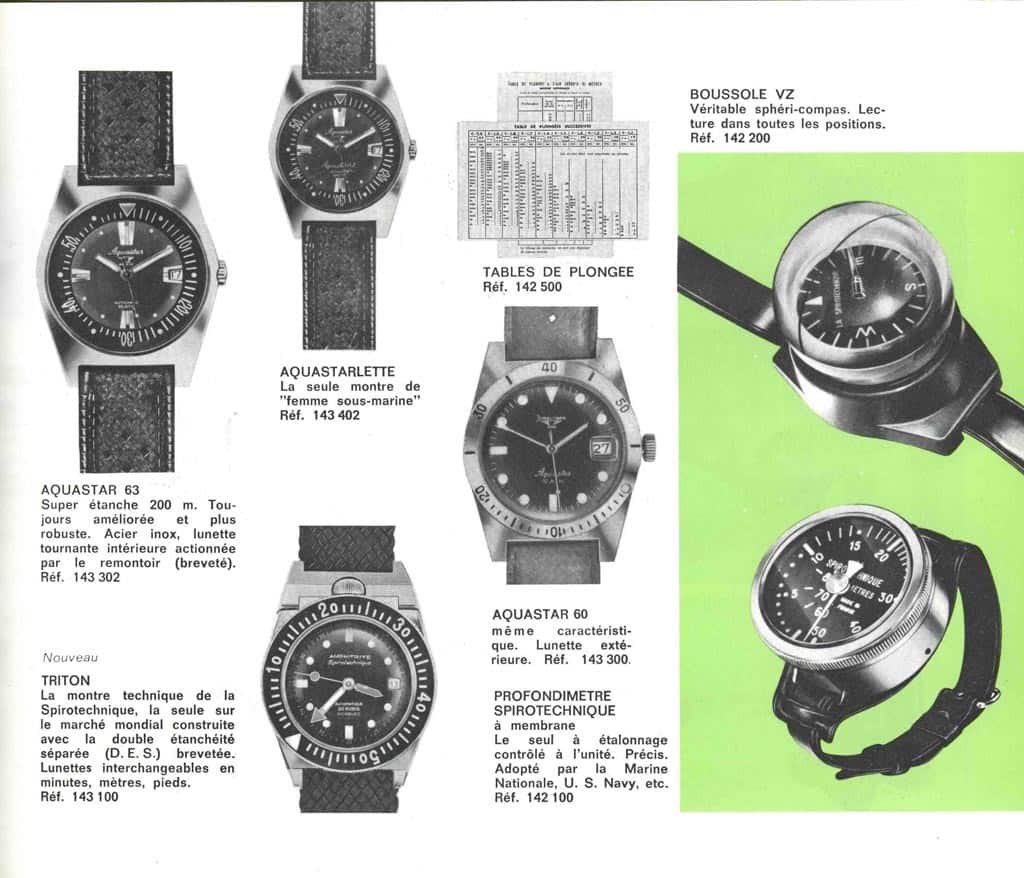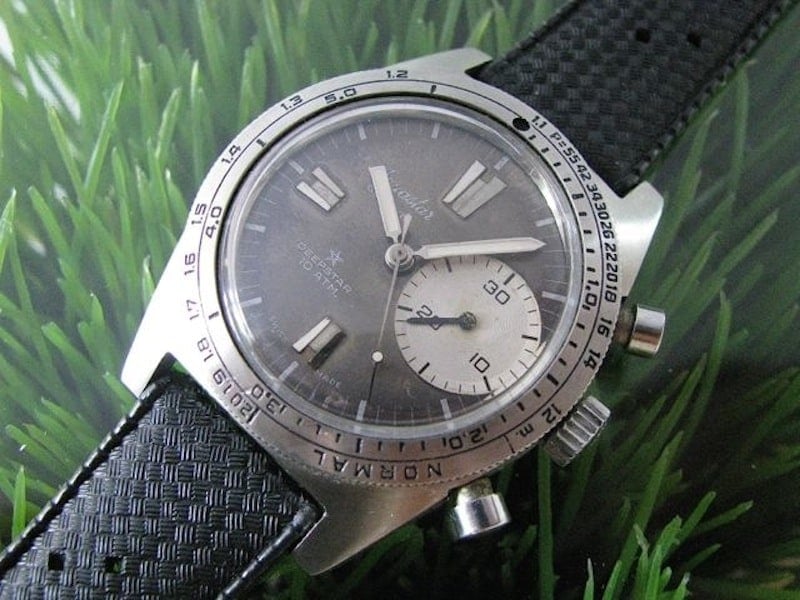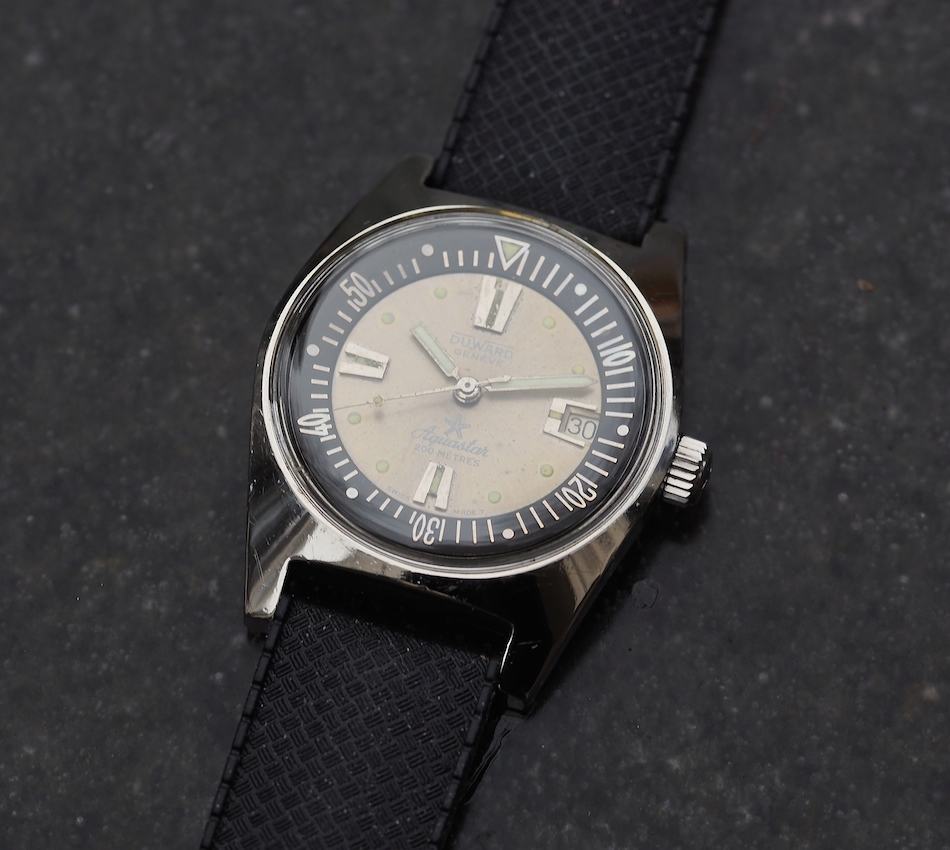#TBT The Aquastar 63 Diver – The Originator of an Iconic Case
Today, on #TBT, we’re going to take a look at a popular vintage dive watch: the Aquastar 63. This diver is popular because it’s relatively plentiful and despite an upward surge in prices, examples can still be found at reasonable levels. Plus, this watch ushered in the use of a case design that we’ve seen the world over – and, it threw in some nifty features as well. Due to its murky dial and highly polished case, it’s a bear to photograph – so be warned!

An original ad featuring the Aquastar 63 (photo courtesy of uhrforum.de)
Duward, an Aquastar by any other name
Aquastar is a watch company that was founded in Geneva in 1962 (seemingly as a sub brand of JeanRichard). From the name, you guessed it; the brand was focused on watches that could be used in and around the water. From dive watches to “inventing” a countdown timer in their Regatta watches, the brand was an active one prior to the quartz crisis. And, since I’ll refer to this watch as Aquastar within the article, it’s worth a little explanation on why the watch states “Duward” on the dial. Interestingly, and perhaps due to tariffs within Europe prior to the formation of the EU, Aquastar marketed their watches (with slight variations) under a number of names depending on the country of sale. The Aquastar 63 you see here actually contains both “Aquastar” and “Duward” on the dial, and it is the latter that tells us that it was made for the Spanish market. Other Aquastar co-names were Lorenz, JeanRichard and more!

The Aquastar Deepstar Chrono (photo courtesy of vintagewatchclassics.com)
Jacques Cousteau wore an Aquastar
Like so many early dive watch brands, Aquastar even had their day in the sun – erm, water – with Jacques Cousteau. The brand made an interesting watch called the Deepstar that became the first 100M diving chronograph. It was tested by, you guessed it, Jacques Cousteau. Today, these rare chronographs command high prices and are rarely seen in great condition. However, we are here to talk about the accessible today, so let’s get back to the Aquastar 63.

The lovely Aquastar 63
Coming in with a beautifully polished 37.5mm stainless steel case, the Aquastar 63 was a relatively large watch when it was released during the early to mid-1960’s. Comparing the Aquastars with similar watches from the time such as the original 35mm Zodiac Sea Wolf or the Bulova 666 diver, the 63’s are relative giants. Compared to something like a Submariner, they’re certainly smaller and thinner despite a listed water resistance of 200M. Even the domed acrylic crystal barely emerges above the case. What the watch loses in pure mass, though, it makes up with its truly long, somewhat blocky lug design that houses a 19mm lug width.

The Aquastar 63 case was everywhere
The Aquastar 63 case design, with its squared inner recess, became an icon and you’ve seen it used on scores of watches. I’d guess that with its relatively simple shape, total lack of chamfering, and large flat surfaces, it was an easy one to crank out in bulk. Polishing it or giving it a matte finish must have been a breeze as well. Consequently, we’ve seen this design on everything from the Seiko 62MAS, the reviewed Bulova Sea Hunter, Wakmann’s, Gerard Perregaux Olimpicos, and so many more. To be very open with you, it was this basic design and commonality that kept me from acquiring an Aquastar for so long, but staring at them over time finally drove me to grabbing one. I’ll come back with “on the wrist impressions” in a bit.

The first rotating inner dive bezel?
Back to innovation…Aquastar claims to have invented the rotating inner diving bezel. While most would argue successfully that an external bezel is more leakproof, Aquastar was likely aiming to appeal to divers who had concerns about accidentally moving their bezels when knocking into things. Aside from the leaking issue, the novel part on this watch is that it’s A.Schild 1713 automatic can be hand wound with the non-screwdown crown in but doing so turns the bezel. Going back and forth with the crown creates a ratcheting effect and it’s certainly interesting. Essentially, if you wish to wind the watch to get it started, you simply need to set the bezel afterwards. When pulling the crown out to set the time, a gear disengages the crown stem from the bezel, and it is left stationary during adjustment. It’s cool, a bit fragile and the most important thing to look at when buying one of these watches.

The Aquastar 63 is well finished
From a finishing perspective, the Aquastar 63 contains a number of really thoughtful cues. The crown is signed, which is always a rare nicety for small brands of this age. But the true gem-like character of this watch is actually exhibited on its backside. Yes, the case back is amazing. With that great script “Aquastar” and starfish logo on the back, it’s dated in a really cool way. But it’s the ridging used to help gain grip when unscrewing the case back that absolutely makes this one of the more unique “rear doors”. I’ve not seen other brands use such a method and for all the money likely saved on the case itself, this seems like a really expensive case back to produce. Either way, it’s charming for sure.

One amazing case back
Flipping the Aquastar 63 over to its more commonly seen side, you’re met with the big internally rotating bezel. The script and the layout actually remind of a mid to late 1960’s Ford Mustang gauge package – also laid out radially. It’s seriously retro, often missing much of its chrome plated finishing on the numbers themselves, and topped with a tritium arrow at 12:00. Lume-wise, Aquastar brought some more thoughtfulness to the game by adding yellow lume dots at the hours and using green for the hour and minutes hands. Curiously, the sweep seconds hand lume dot appears to be yellow. All this would help a diver check his watch in a low light condition at a quick glance. On most pieces, this lume has seriously degraded. The 3/6/9/12 markers (including around the date window at 3:00) are applied and somehow thematically fit the case style. They’re often corroded or even missing on many pieces that have unfortunately encountered moisture over the years. And then there’s the dial…

Seriously fragile dials
Curiously, the brand often used a dark grey green sunray finish for its dials and here the Aquastar 63 is no exception. It’s a unique shade not really seen anywhere else (the Seiko 62MAS coming in again as relatively similar) and it’s captivatingly attractive in the right lighting at an angle. However, it is tough to photograph and, as seen on so many Aquastars, seems to be made of the most fragile stuff on earth. Moisture was clearly not a friend of whatever material employed on the surface. It’s not uncommon to find these watches with barely discernible white font on the dial or even large peeling patches of color. One gets the feeling that these watches were truly used, rarely serviced or that the whole spinning bezel idea simply resulted in some poor seals. Whatever it is, it makes finding a nice 63 difficult but rewarding at the same time.

Grabbing an Aquastar 63
I picked up, rather Blaise helped me to pick up, this Aquastar from a seller last year in Italy. At roughly $400, I figured it was worth a go. Upon receiving, I was more impressed than I had ever been from pictures on forums or eBay. On distressed leather, an olive one-piece nylon strap, or a repro Tropic strap, the Aquastar 63 comes off as a surprisingly rugged, roughneck-looking diver. It feels a little fragile when compared to a big outer rotating bezel diver, but it’s not insubstantial. You can see that it has some nice presence on the wrist and it’s extremely comfortable due to its size and thin case. The Schild movement is a serious workhorse with dependable accuracy, although my date wheel has stopped advancing (an easy fix), and the inner bezel works faithfully. Overall, it was a good pickup.

Like so many other watches, the once very common Aquastars – honestly, there were seemingly 10+ on eBay at any given time up until about 9 months ago – have become prized. What were once $300-500 watches now seem to command $700 and up in decent condition. Figure on thousands if you’re lucky enough to score one of the column wheel Valjoux-powered chronographs. As mentioned above, condition is definitely something to watch out for – or simply to ensure the watch’s patina meets your approval – and check the little things like the crown, bezel functionality, and that the hands and applied markers are present.
The Aquastar 63 and its familial relatives are semi-esoteric pieces to own and I’d admittedly struggle to pay huge money for one. However, it’s a satisfying piece to own and it’s just one more diver from the 1960’s from a smaller company that brought in its own ideas to help serve the growing population of underwater explorers. For that reason alone, I think it’s worthwhile to add to the collection.
